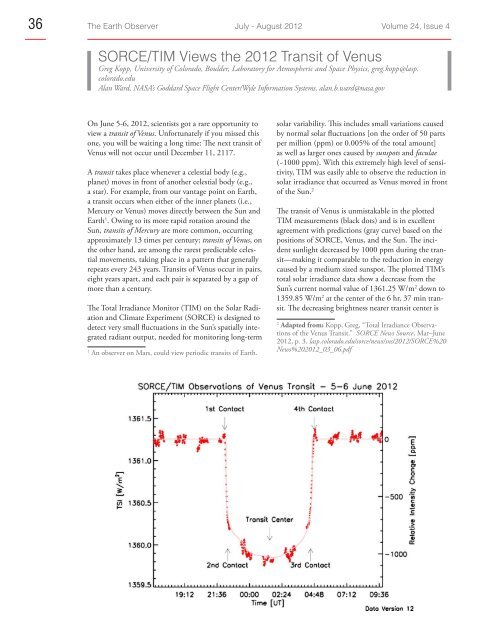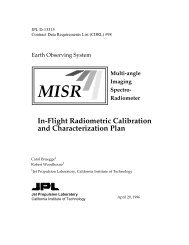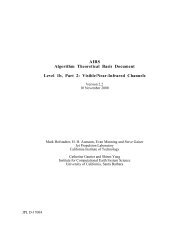Download - NASA's Earth Observing System
Download - NASA's Earth Observing System
Download - NASA's Earth Observing System
You also want an ePaper? Increase the reach of your titles
YUMPU automatically turns print PDFs into web optimized ePapers that Google loves.
36<br />
The <strong>Earth</strong> Observer July - August 2012 Volume 24, Issue 4<br />
SORCE/TIM Views the 2012 Transit of Venus<br />
Greg Kopp, University of Colorado, Boulder, Laboratory for Atmospheric and Space Physics, greg.kopp@lasp.<br />
colorado.edu<br />
Alan Ward, NASA’s Goddard Space Flight Center/Wyle Information <strong>System</strong>s, alan.b.ward@nasa.gov<br />
On June 5-6, 2012, scientists got a rare opportunity to<br />
view a transit of Venus. Unfortunately if you missed this<br />
one, you will be waiting a long time: The next transit of<br />
Venus will not occur until December 11, 2117.<br />
A transit takes place whenever a celestial body (e.g.,<br />
planet) moves in front of another celestial body (e.g.,<br />
a star). For example, from our vantage point on <strong>Earth</strong>,<br />
a transit occurs when either of the inner planets (i.e.,<br />
Mercury or Venus) moves directly between the Sun and<br />
<strong>Earth</strong> 1 . Owing to its more rapid rotation around the<br />
Sun, transits of Mercury are more common, occurring<br />
approximately 13 times per century; transits of Venus, on<br />
the other hand, are among the rarest predictable celestial<br />
movements, taking place in a pattern that generally<br />
repeats every 243 years. Transits of Venus occur in pairs,<br />
eight years apart, and each pair is separated by a gap of<br />
more than a century.<br />
The Total Irradiance Monitor (TIM) on the Solar Radiation<br />
and Climate Experiment (SORCE) is designed to<br />
detect very small fluctuations in the Sun’s spatially integrated<br />
radiant output, needed for monitoring long-term<br />
1<br />
An observer on Mars, could view periodic transits of <strong>Earth</strong>.<br />
solar variability. This includes small variations caused<br />
by normal solar fluctuations [on the order of 50 parts<br />
per million (ppm) or 0.005% of the total amount]<br />
as well as larger ones caused by sunspots and faculae<br />
(~1000 ppm). With this extremely high level of sensitivity,<br />
TIM was easily able to observe the reduction in<br />
solar irradiance that occurred as Venus moved in front<br />
of the Sun. 2 2<br />
The transit of Venus is unmistakable in the plotted<br />
TIM measurements (black dots) and is in excellent<br />
agreement with predictions (gray curve) based on the<br />
positions of SORCE, Venus, and the Sun. The incident<br />
sunlight decreased by 1000 ppm during the transit—making<br />
it comparable to the reduction in energy<br />
caused by a medium sized sunspot. The plotted TIM’s<br />
total solar irradiance data show a decrease from the<br />
Sun’s current normal value of 1361.25 W/m 2 down to<br />
1359.85 W/m 2 at the center of the 6 hr, 37 min transit.<br />
The decreasing brightness nearer transit center is<br />
2<br />
Adapted from: Kopp, Greg, “Total Irradiance Observations<br />
of the Venus Transit.” SORCE News Source, Mar–June<br />
2012, p. 3. lasp.colorado.edu/sorce/news/sns/2012/SORCE%20<br />
News%202012_03_06.pdf







